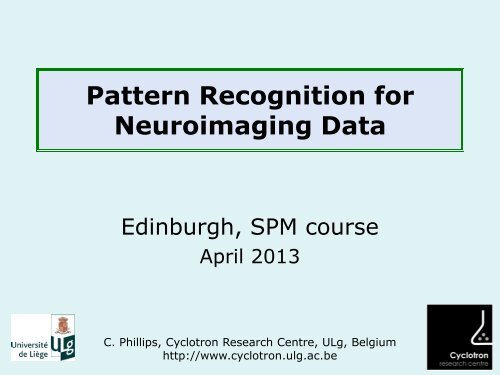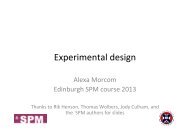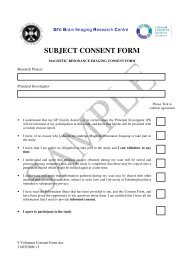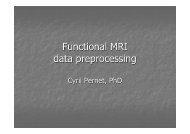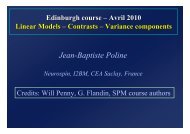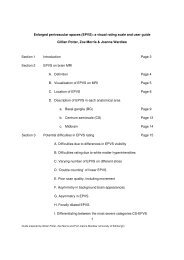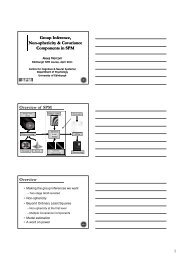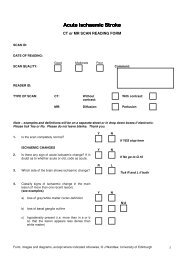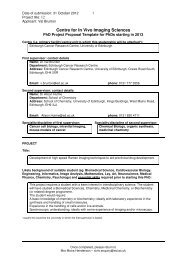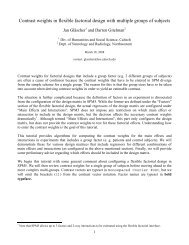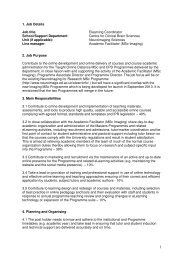Pattern classification - Brain Research Imaging Centre Edinburgh
Pattern classification - Brain Research Imaging Centre Edinburgh
Pattern classification - Brain Research Imaging Centre Edinburgh
Create successful ePaper yourself
Turn your PDF publications into a flip-book with our unique Google optimized e-Paper software.
<strong>Pattern</strong> Recognition for<br />
Neuroimaging Data<br />
<strong>Edinburgh</strong>, SPM course<br />
April 2013<br />
C. Phillips, Cyclotron <strong>Research</strong> <strong>Centre</strong>, ULg, Belgium<br />
http://www.cyclotron.ulg.ac.be
Overview<br />
• Introduction<br />
– Univariate & multivariate approaches<br />
– Data representation<br />
• <strong>Pattern</strong> Recognition<br />
– Machine learning<br />
– Validation & inference<br />
– Weight maps & feature selection<br />
– fMRI application<br />
– Multiclass problem<br />
• Conclusion & PRoNTo
Overview<br />
• Introduction<br />
– Univariate & multivariate approaches<br />
– Data representation<br />
• <strong>Pattern</strong> Recognition<br />
– Machine learning<br />
– Validation & inference<br />
– Weight maps & feature selection<br />
– fMRI application<br />
– Multiclass problem<br />
• Conclusion & PRoNTo
Introduction<br />
fMRI time series<br />
= 4D image<br />
= time series of 3D fMRI’s<br />
= 3D array of time series.
BOLD signal<br />
Univariate vs. multivariate<br />
Standard univariate approach (SPM)<br />
Standard Statistical Analysis (encoding)<br />
Input<br />
Time<br />
...<br />
Voxel-wise<br />
GLM model<br />
estimation<br />
Independent<br />
statistical<br />
test at each<br />
voxel<br />
Correction<br />
for<br />
multiple<br />
comparisons<br />
Output<br />
Univariate statistical<br />
Parametric map<br />
Find the mapping g from explanatory variable X to observed<br />
data Y<br />
g: X Y
Univariate vs. multivariate<br />
Multivariate approach, aka. “pattern recognition”<br />
Input<br />
…<br />
Volumes from task 1<br />
…<br />
Volumes from task 2<br />
Training<br />
Phase<br />
Output<br />
Classifiers weights or<br />
discrimination map<br />
New example<br />
Test Phase<br />
Prediction: task 1 or task 2<br />
Find the mapping h from observed data Y to explanatory<br />
variable X<br />
h: Y X
Neuroimaging data<br />
“feature<br />
vector” or<br />
“data point”<br />
Data dimensions<br />
3D brain image<br />
•dimensionality of a “data point” = #voxels considered<br />
•number of “data point” = #scans/images considered<br />
Note that #voxels >> #scans !<br />
“ill posed problem”
Advantages of pattern recognition<br />
Accounts for the spatial correlation of the data<br />
(multivariate aspect)<br />
• images are multivariate by nature.<br />
• can yield greater sensitivity than conventional (univariate)<br />
analysis.<br />
Enable <strong>classification</strong>/prediction of individual<br />
subjects<br />
• ‘Mind-reading’ or decoding applications<br />
• Clinical application<br />
Haynes & Rees, 2006
<strong>Pattern</strong> recognition framework<br />
Input (brain scans)<br />
X 1<br />
X 2<br />
X 3<br />
No mathematical<br />
model available<br />
Machine<br />
Learning<br />
Methodology<br />
Output (control/patient)<br />
y 1<br />
y 2<br />
y 3<br />
Computer-based procedures that learn a function from a series of examples<br />
Training Examples:<br />
(X 1 ,y 1 ),...,(X s ,y s )<br />
Learning/Training Phase<br />
Generate a function or classifier<br />
f such that<br />
f<br />
Testing Phase<br />
Test Example X i<br />
f(x i ) y i<br />
f(X i ) = y i<br />
Prediction
Overview<br />
• Introduction<br />
– Univariate & multivariate approaches<br />
– Data representation<br />
• <strong>Pattern</strong> Recognition<br />
– Machine learning<br />
– Validation & inference<br />
– Weight maps & feature selection<br />
– fMRI application<br />
– Multiclass problem<br />
• Conclusion & PRoNTo
voxel 2<br />
Classification example<br />
L<br />
R<br />
task 1 task 2 task 1 task 2<br />
task ?<br />
4 2<br />
volume in t 1 volume in t 2<br />
volume in t 3 volume in t 4<br />
Volume with<br />
unknown label<br />
Different classifiers<br />
will compute different<br />
hyperplanes!<br />
2<br />
volume in t 2<br />
volume in t 3<br />
volume in t 4<br />
volume in t 1<br />
w<br />
4<br />
voxel 1<br />
Note: task1/2 ~ disease/controle
Neuroimaging data<br />
“feature<br />
vector” or<br />
“data point”<br />
<strong>Brain</strong> volume<br />
Problem:1000’s of features vs. 10’s of data points<br />
Possible solutions to dimensionality problem:<br />
– Feature selection strategies (e.g. ROIS, select<br />
only activated voxels)<br />
– (Searchlight)<br />
– Kernel Methods
Kernel approaches<br />
• Mathematical trick! powerful and unified framework<br />
(e.g. <strong>classification</strong> & regression)<br />
• Consist of two parts:<br />
- build the kernel matrix (mapping into the feature space)<br />
- train using the kernel matrix (designed to discover linear<br />
patterns in the feature space)<br />
• Advantages:<br />
- computational shortcut represent linear patterns<br />
efficiently in high dimensional space.<br />
- Using the dual representation with proper regularization<br />
efficient solution of ill-conditioned problems.<br />
• Examples Support Vector Machine (SVM), Gaussian<br />
Processes (GP), Kernel Ridge Regression (KRR),…
Kernel matrix<br />
Kernel matrix = similarity measure<br />
<strong>Brain</strong> scan 2<br />
Dot product = (4*-2)+(1*3) = -5<br />
<strong>Brain</strong> scan 4<br />
4 1<br />
-2 3<br />
The “kernel function”<br />
•2 patterns x and x* a real number characterizing their similarity<br />
(~distance measure).<br />
•simple similarity measure = a dot product linear kernel.
Linear classifier<br />
• hyperplanes through the feature space<br />
• parameterized by<br />
– a weight vector w and<br />
– a bias term b.<br />
• weight vector w = linear combination of<br />
training examples x i (where i = 1,…,N and N is the number<br />
of training examples)<br />
Find the α i !!!<br />
w =<br />
N<br />
å<br />
i =1<br />
a i<br />
x i
Linear classifier prediction<br />
General equation: making predictions for a test<br />
example x * with kernel methods<br />
w =<br />
N<br />
å<br />
i =1<br />
a i<br />
x i<br />
kernel<br />
definition<br />
f (x *<br />
) = w× x *<br />
+ b<br />
f (x *<br />
) =<br />
f (x *<br />
) =<br />
N<br />
å<br />
i =1<br />
N<br />
å<br />
i =1<br />
a i<br />
x i<br />
× x *<br />
+ b<br />
a i<br />
K(x i<br />
,x *<br />
) + b<br />
Primal representation<br />
Dual representation<br />
f(x * ) =<br />
signed distance to boundary (<strong>classification</strong>)<br />
predicted score (regression)
Support Vector Machine<br />
SVM = “maximum margin” classifier<br />
(w ⊤ x i + b) =-1<br />
(w ⊤ x i + b) =+1<br />
(w ⊤ x i + b) < 0<br />
(w ⊤ x i + b) > 0<br />
w<br />
w =<br />
N<br />
å<br />
i =1<br />
a i<br />
x i<br />
Support vectors have α i ≠ 0<br />
Data: , i=1,..,N<br />
Observations: x i R d<br />
Labels: y i {-1,+1}
Illustrative example: Classifiers as decision functions<br />
Examples of class 1<br />
…<br />
Voxel 1 Voxel 2 Voxel 1 Voxel 2<br />
Weight vector or<br />
Discrimination map<br />
Examples of class 2<br />
Training<br />
w 1 = +5 w 2 = -3<br />
Voxel 1 Voxel 2 Voxel 1 Voxel 2<br />
…<br />
New example<br />
v 1 = 0.5 v 2 = 0.8<br />
Testing<br />
f(x) = (w 1 *v 1 +w 2 *v 2 )+b<br />
= (+5*0.5-3*0.8)+0<br />
= 0.1<br />
Positive value<br />
Class 1
SVM vs. GP<br />
SVM<br />
Hard binary <strong>classification</strong><br />
– simple & efficient, quick calculation but<br />
– NO ‘grading’ in output {-1, 1}<br />
Gaussian Processes<br />
probabilistic model<br />
– more complicated, slower calculation but<br />
– returns a probability [0 1]<br />
– can be multiclass
Overview<br />
• Introduction<br />
– Univariate & multivariate approaches<br />
– Data representation<br />
• <strong>Pattern</strong> Recognition<br />
– Machine learning<br />
– Validation & inference<br />
– Weight maps & feature selection<br />
– fMRI application<br />
– Multiclass problem<br />
• Conclusion & PRoNTo
Training set<br />
Test set<br />
…<br />
…<br />
…<br />
…<br />
…<br />
…<br />
…<br />
…<br />
Validation principle<br />
Samples<br />
label variables:<br />
var 1 var 2 var 3 … var m<br />
1<br />
2<br />
3<br />
…<br />
1 …<br />
-1 …<br />
-1 …<br />
…<br />
Trained<br />
classifier<br />
i<br />
1 …<br />
i+1<br />
i+2<br />
1 …<br />
1 …<br />
1<br />
-1<br />
…<br />
…<br />
…<br />
n<br />
-1 …<br />
-1<br />
True<br />
label<br />
Accuracy evaluation<br />
Predicted<br />
label
M-fold cross-validation<br />
• Split data in 2 sets: “train” & “test”<br />
evaluation on 1 “fold”<br />
• Rotate partition and repeat<br />
evaluations on M “folds”<br />
• Applies to scans/events/blocks/subjects/…<br />
Leave-one-out (LOO) approach
Confusion matrix & accuracy<br />
Confusion matrix<br />
= summary table<br />
Accuracy estimation<br />
• Class 0 accuracy, p 0 = A/(A+B)<br />
• Class 1 accuracy, p 1 = D/(C+D)<br />
• Accuracy, p = (A+D)/(A+B+C+D)<br />
Other criteria<br />
• Positive Predictive Value, PPV = D/(B+D)<br />
• Negative Predictive Value, NPV = A/(A+C)
Accuracy & Dataset balance<br />
Watch out if #samples/class are different!<br />
Example:<br />
Good overall accuracy (72%) but<br />
•Majority class (N 1 = 80), excellent accuracy (90%)<br />
•Minority class (N 2 = 20), poor accuracy (0%)<br />
Good practice:<br />
Report<br />
•class accuracies [p 0 , p 1 , …, p C ]<br />
•balanced accuracy p bal = (p 0 + p 1 + …+ p C )/C
Regression MSE<br />
• LOO error in one fold<br />
• Across all LOO folds<br />
Out-of-sample “mean squared error” (MSE)<br />
Other measure:<br />
Correlation between predictions<br />
(across folds!) and ‘true’ targets
Inference by permutation testing<br />
• H 0 : “class labels are non-informative”<br />
• Test statistic = CV accuracy<br />
• Estimate distribution of test statistic under H0<br />
Random permutation of labels<br />
Estimate CV accuracy<br />
Repeat M times<br />
• Calculate p-value<br />
as
Overview<br />
• Introduction<br />
– Univariate & multivariate approaches<br />
– Data representation<br />
• <strong>Pattern</strong> Recognition<br />
– Machine learning<br />
– Validation & inference<br />
– Weight maps & feature selection<br />
– fMRI application<br />
– Multiclass problem<br />
• Conclusion & PRoNTo
voxel 1<br />
Weight vector<br />
task1<br />
Weight vector interpretation<br />
weight (or discrimination) image !<br />
how important each voxel is<br />
for which class “it votes” (mean centred data & b=0)<br />
1 4<br />
task2<br />
0.5 0.3<br />
task1<br />
3<br />
2.5<br />
2<br />
H: Hyperplane<br />
Weight vector<br />
W = [0.45 0.89]<br />
b = -2.8<br />
2 3<br />
task2<br />
1.5<br />
1 1.5<br />
1<br />
0.45 0.89<br />
task1<br />
2.5 4.5<br />
task2<br />
0.5<br />
0<br />
w<br />
0 1 2 3 4 5<br />
voxel 2<br />
2 1
Example of masks<br />
Linear machine<br />
Weight map<br />
29
Feature selection<br />
• 1 sample image<br />
1 predicted value<br />
• use ALL the voxels<br />
NO thresholding of weight allowed!<br />
Feature selection:<br />
• a priori mask<br />
• a priori ‘filtering’<br />
• recursive feature elimination/addition<br />
nested cross-validation<br />
(MUST be independent from test data!)
Overview<br />
• Introduction<br />
– Univariate & multivariate approaches<br />
– Data representation<br />
• <strong>Pattern</strong> Recognition<br />
– Machine learning<br />
– Validation & inference<br />
– Weight maps & feature selection<br />
– fMRI application<br />
– Multiclass problem<br />
• Conclusion & PRoNTo
Level of inference<br />
fMRI designs<br />
•within subject ≈ FFX with SPM<br />
‘decode’ subject’s brain state<br />
•between subjects ≈ RFX with SPM<br />
‘classify’ groups, or<br />
regress subjects’ parameter
Design<br />
Between subjects<br />
•2 groups: group A vs. group B<br />
•1 group: 2 conditions per subject<br />
Extract 1 (or 2) summary image(s) per<br />
subject, and classify<br />
Leave-one-out (LOO) cross-validation:<br />
•Leave one subject out (LOSO)<br />
•Leave one subject per group out (LOSGO)<br />
Note: this works for any type of image…
Design:<br />
Within subject<br />
• Block or event-related design<br />
• Accounting for haemodynamic function<br />
Use single scans<br />
C1 C1 C1 BL BL BL C2 C2 C2 BL BL BL<br />
Data Matrix =<br />
voxels<br />
Single volumes
Design:<br />
Within subject<br />
• Block or event-related design<br />
• Accounting for haemodynamic function
Design:<br />
Within subject<br />
• Block or event-related design<br />
• Accounting for haemodynamic function<br />
Averaging/deconvolution<br />
C1 C1 C1 BL BL BL C2 C2 C2 BL BL BL<br />
Data Matrix =<br />
voxels<br />
Mean of volumes or betas<br />
How to?<br />
• Average scans over<br />
blocks/events<br />
• Parameter estimate from<br />
the GLM with 1 regressor<br />
per block/event
Design:<br />
Within subject<br />
• Block or event-related design<br />
• Accounting for haemodynamic function<br />
Leave-one-out (LOO) cross-validation:<br />
• Leave one session/run out<br />
• Leave one block/event out<br />
(danger of dependent data!!!)
Overview<br />
• Introduction<br />
– Univariate & multivariate approaches<br />
– Data representation<br />
• <strong>Pattern</strong> Recognition<br />
– Machine learning<br />
– Validation & inference<br />
– Weight maps & feature selection<br />
– fMRI application<br />
– Multiclass problem<br />
• Conclusion & PRoNTo
Multiclass problem<br />
Multiclass<br />
machine<br />
C1<br />
Binary machine<br />
& one-vs.-others<br />
C1<br />
Binary machine<br />
& one-vs.-one<br />
C1<br />
C2<br />
C3<br />
C2<br />
C3<br />
C2<br />
C3<br />
ECOC SVM codewords<br />
C1-C2 C1-C3 C2-C3 L<br />
C1 1 1 0 3<br />
C2 -1 0 1 2<br />
C3 0 -1 -1 1<br />
Example -1 -1 -1 C3<br />
“Error-Correcting<br />
Output Coding”<br />
(ECOC) approach
Overview<br />
• Introduction<br />
– Univariate & multivariate approaches<br />
– Data representation<br />
• <strong>Pattern</strong> Recognition<br />
– Machine learning<br />
– Validation & inference<br />
– Weight maps & feature selection<br />
– fMRI application<br />
– Multiclass problem<br />
• Conclusion & PRoNTo
Conclusions<br />
Key points:<br />
• More sensitivity (~like omnibus test with SPM)<br />
• NO local (voxel/blob) inference<br />
CANNOT report coordinates nor<br />
thresholded weight map<br />
• Require cross-validation (split in train/test sets)<br />
report accuracy/PPV (or MSE)<br />
• MUST assess significance of accuracy<br />
permutation approach
PRoNTo<br />
“<strong>Pattern</strong> Recognition for Neuroimaging<br />
Toolbox”, aka. PRoNTo :<br />
http://www.mlnl.cs.ucl.ac.uk/pronto/<br />
with references, manual, demo data, course, etc.<br />
Paper: http://dx.doi.org/10.1007/s12021-013-9178-1
Thank you for your attention!<br />
Any question?<br />
Thanks to the PRoNTo Team for the borrowed slides.


